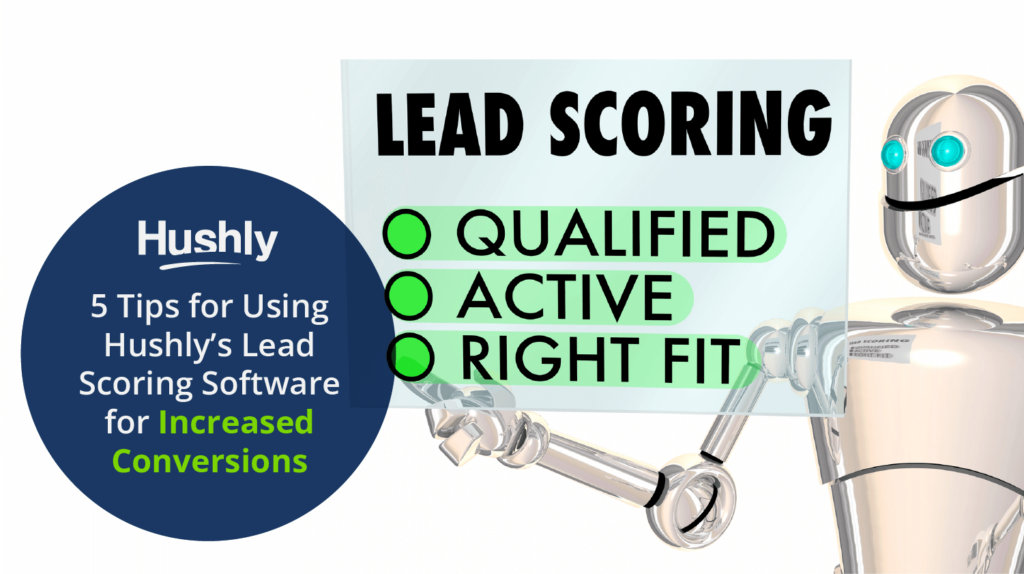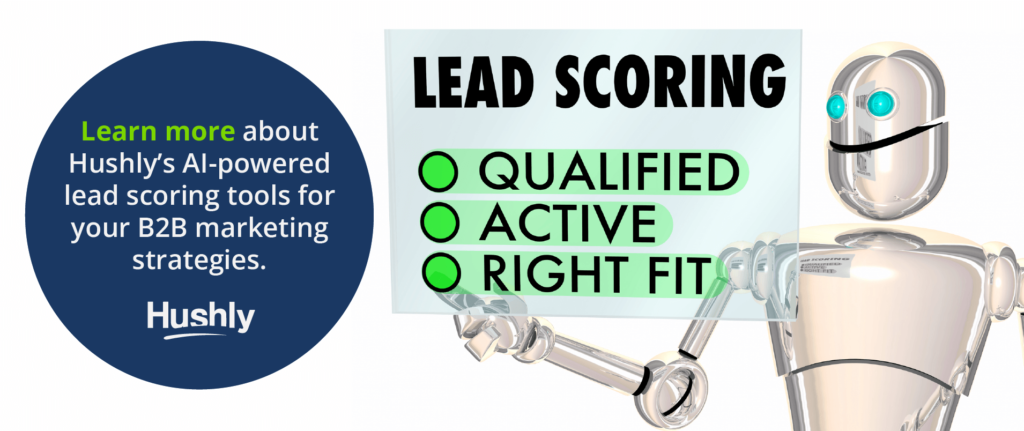Filters
Content Type
Topic
5 Tips for Using Hushly’s Lead Scoring Software for Increased Conversions
A fast-food restaurant ad playing at the Super Bowl looks vastly different than a fast-food restaurant ad playing on a kid’s YouTube channel. Why is that? Even though it’s the same restaurant and offers the same products, it changes its message based on the audience and what that audience wants most.
Are you using the same marketing techniques for all your leads, or do you segment them based on their interests, industry, and needs?
Learn how Hushly can help you accurately segment your leads to boost your conversion rate and why we have one of the best lead scoring software options.

What Is Lead Scoring?
Lead scoring software assigns point values to lead actions to determine their sales readiness.
Most of your website visitors won’t purchase during their visit. Even when you collect a new lead, they may still not be ready to buy, as only 10-15% of leads turn into customers. That’s why businesses call the stages between the first touchpoint and final sale a buyer’s journey because it takes time.
Where leads are in this journey is crucial for how you market to them. A fresh lead may still be on the fence about whether they trust your brand and will not respond favorably to a sales call. However, a lead who has downloaded five assets, opens nearly every nurturing email, and matches your target buyer demographics would be very likely to respond to sales calls or emails.
Lead scoring determines where a lead is in their journey and the best approach for marketing by adding or subtracting points based on lead activity. For example, a lead may receive five points for every email they open and ten points for every asset they download. Once a lead reaches the lead scoring threshold, they move from being a marketing-qualified lead to a sales-qualified lead, and the sales team takes over to convert that lead.
However, lead scoring also works in reverse. If a lead visits the career page or doesn’t open emails for several weeks, your system may subtract points, moving them backward in their journey so they can receive more foundational nurturing.
How to Use Lead Scoring for Segmentation
If you want to maximize your lead scoring benefits, you’ll use it beyond just determining when a lead is sales-ready. Lead scoring is also a powerful method for more accurate segmentation.
Segmentation is foundational to customized marketing. In segmentation, you divide your leads into smaller groups based on shared interests, needs, or firmographic characteristics. Then, you can market to that smaller group based on their similarities to create a more relevant marketing experience.
Segmenting leads by their place in the buyer’s journey allows you to customize your marketing by their purchase intent. One segment may be B2B decision makers who don’t realize they have a need. That marketing content would focus on creating demand. Another segment would include those with high lead scores. That marketing content would be strongly sales focused.
You can use your lead scoring to divide groups even further. For example, you might group together those who showed direct interest by signing up for your free trial or talking with a sales rep. Then another group is those who showed indirect interest, like those who downloaded multiple assets, attended webinars, and opened emails but haven’t made a clear purchase intent.
When you can customize your approach to each lead’s intent based on their lead score, you’re more likely to convert those leads because you can provide the information they need to make an informed buying decision.
5 Tips for Using Hushly’s Lead Scoring Software to Segment Your Leads
Use these five tips for using Hushly’s predictive lead scoring software to improve lead scoring and segmentation.
1. Use Demand Capture Tools
Hushly offers several demand capture tools that collect leads and analyze lead data to segment them more accurately.
Lead capture forms are valuable sources of lead-scoring data. However, the forms shouldn’t be dozens of fields long. Otherwise, most visitors won’t bother filling them out. Hushly uses powerful microforms with just two or three fields. The fields collect enough data to understand a user’s intent.
For instance, business email users automatically enter your B2B buyer into an appropriate B2B lead nurturing campaign.
The demographic or firmographic information you collect from your forms will help you segment leads by who they are so you can customize your marketing to their role and industry.
2. Analyze Visitor Behavior
As visitors move through your website, they leave digital footprints that tell a story of their intent. Hushly’s intelligent platform reads that story and automatically produces nurturing content based on visitors’ behavior, like which pages they visit and assets they download.
That data also plays a role in lead scoring as it tells you why your website visitor is interested in your brand. You can use those lead scores to segment the leads based on their interests and activity.
3. Create Multi-Asset Experiences
To accurately segment your audience, you want them to interact with multiple assets. The more assets they interact with, the more scores you have to understand the lead, where they are in their buyer’s journey, and their end goal (or the solution they’re looking for).
Gating each asset individually can dissuade visitors from downloading multiple assets or may keep them from finding relevant content. Hushly overcomes this roadblock by creating a single form that opens multiple assets so visitors can easily download several assets without reentering their contact information.
Additionally, Hushly’s platform recommends similar relevant assets with each download to encourage further engagement.
4. Create Email Flows
Every action should lead to a follow-up action. Usually, you’ll provide the lead with the next step through a call-to-action button or link at the end of your content, assets, or emails.
By providing the next action, you ensure leads continue gaining points to increase their lead score and move them closer to a sale. It also encourages them to keep engaging with your content so you better understand their needs and the best segment for nurturing.
Email flows should be the natural follow-up action to your online content. Emails are customized communications that allow you to track customer engagement more accurately. For example, leads gain points for opening and engaging with emails, helping you know which email segments they respond best to.
5. Add AI Content Chat
If you want to know what your customers want, why not ask yourself?
Operating a live chat can be overwhelming and may not fit within your resources. That’s why Hushly provides AI chat and responsive content.
Website visitors can ask the ChatGPT assistant questions they can’t find on the website. Not only does the chat help visitors find answers, but it also feeds the conversation back to your marketing team so you understand what the lead is looking for.
Use the chat data in your lead scoring platform to segment your lead based on needs and information they’re most interested in to ensure you share relevant insights that move them towards a sale.
Boost Your Conversion Rate Through Advanced Lead Scoring Software
Do you want a higher conversion rate but aren’t sure where to adjust your strategy?
Boosting your conversion rate is possible with highly customized marketing approaches based on hyper-targeted marketing segments.
Hushly helps you build those segments using our powerful lead-scoring tools that use AI and machine learning to understand your visitors. You don’t need extensive developer experience to enjoy the benefits of the best predictive lead scoring software. We do the hard work behind the scenes so you can focus on nurturing and converting the leads in your segments.
Learn more about Hushly’s AI-powered lead scoring tools for your B2B marketing strategies.
The post 5 Tips for Using Hushly’s Lead Scoring Software for Increased Conversions appeared first on Hushly.



